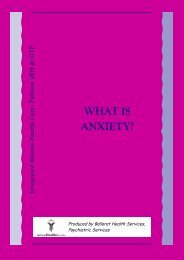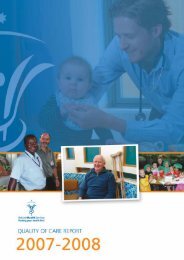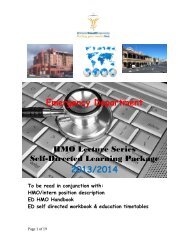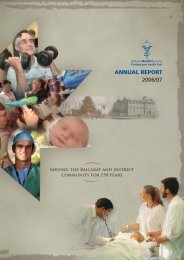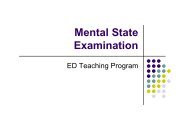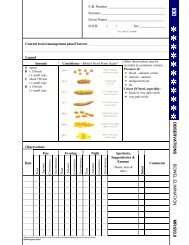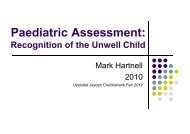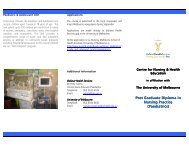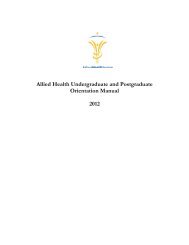2012 Annual Report - Ballarat Health Services
2012 Annual Report - Ballarat Health Services
2012 Annual Report - Ballarat Health Services
Create successful ePaper yourself
Turn your PDF publications into a flip-book with our unique Google optimized e-Paper software.
Note 1: Summary of Signifi cant Accounting Policies (continued)<br />
(i) Expense Recognition<br />
Expenses are recognised as they are incurred and reported in the fi nancial year to<br />
which they relate.<br />
Employee expenses<br />
Employee expenses include:<br />
Wages and salaries;<br />
<strong>Annual</strong> leave;<br />
Sick leave;<br />
Long service leave; and<br />
Superannuation expenses which are reported differently depending upon<br />
whether employees are members of defi ned benefi t or defi ned contribution<br />
plans.<br />
Defi ned contribution plans<br />
In relation to defi ned contribution (i.e. accumulation) superannuation plans, the<br />
associated expense is simply the employer contributions that are paid or payable<br />
in respect of employees who are members of these plans during the reporting<br />
period. Contributions to defi ned contribution superannuation plans are expensed<br />
when incurred.<br />
Defi ned benefi t plans<br />
The amount charged to the Comprehensive Operating Statement in respect<br />
of defi ned benefi t superannuation plans represents the contributions made by<br />
<strong>Ballarat</strong> <strong>Health</strong> <strong>Services</strong> to the superannuation plan in respect to the current<br />
services of current <strong>Ballarat</strong> <strong>Health</strong> <strong>Services</strong> staff during the reporting period.<br />
Superannuation contributions are made to the plans based on the relevant rules<br />
of each plan, and are based upon actuarial advice.<br />
Employees of <strong>Ballarat</strong> <strong>Health</strong> <strong>Services</strong> are entitled to receive superannuation<br />
benefi ts and the <strong>Health</strong> Service contributes to both the defi ned benefi t and<br />
defi ned contribution plans. The defi ned benefi t plan(s) provide benefi ts based on<br />
years of service and fi nal average salary.<br />
The name and details of the major employee superannuation funds and<br />
contributions made by <strong>Ballarat</strong> <strong>Health</strong> <strong>Services</strong> are as follows:<br />
Fund<br />
Contributions Paid or Payable<br />
for the year<br />
<strong>2012</strong><br />
$000<br />
Notes to and forming part of the fi nancial statements for the year ended 30 June <strong>2012</strong>.<br />
2011<br />
$000<br />
Defi ned benefi t plans:<br />
<strong>Health</strong> Super 1,741 1,793<br />
Defi ned contribution plans:<br />
<strong>Health</strong> Super 12,218 11,313<br />
HESTA 2,219 1,856<br />
Emergency <strong>Services</strong> Scheme 540 589<br />
Other 389 410<br />
Total 17,107 15,961<br />
<strong>Ballarat</strong> <strong>Health</strong> <strong>Services</strong> does not recognise any unfunded defi ned benefi t liability<br />
in respect of the superannuation plan because <strong>Ballarat</strong> <strong>Health</strong> <strong>Services</strong> has no<br />
legal or constructive obligation to pay future benefi ts relating to its employees;<br />
its only obligation is to pay superannuation contributions as they fall due. The<br />
Department of Treasury and Finance administers and discloses the State’s defi ned<br />
benefi t liabilities in its fi nancial statements.<br />
Depreciation<br />
Assets with a cost in excess of $2,000 (2010-11 and 2011-12) are capitalised and<br />
depreciation has been provided on depreciable assets so as to allocate their cost<br />
or valuation over their estimated useful lives. Depreciation is generally calculated<br />
on a straight line basis, at a rate that allocates the asset value, less any estimated<br />
residual value over its estimated useful life. Estimates of the remaining useful<br />
lives and depreciation method for all assets are reviewed at least annually, and<br />
adjustments made where appropriate. This depreciation charge is not funded by<br />
the Department of <strong>Health</strong>.<br />
Depreciation is provided on property, plant and equipment, including freehold<br />
buildings, but excluding land. Depreciation begins when the asset is available<br />
for use, which is when it is in the location and condition necessary for it to<br />
be capable of operating in a manner intended by management. Linen used<br />
in the Linen Service is considered a fi xed asset of <strong>Ballarat</strong> <strong>Health</strong> <strong>Services</strong> and<br />
depreciated accordingly.<br />
The following table indicates the expected useful lives of non current assets on<br />
which depreciation charges are based.<br />
<strong>2012</strong> 2011<br />
Buildings 1 to 52 years 1 to 51 years<br />
Kitchen & Catering Equipment 10 years 10 years<br />
Plant & Equipment 10 years 10 years<br />
Medical Equipment 5 years 5 years<br />
Computers & Communications 3 years 3 years<br />
Furniture & Fittings 5 years 5 years<br />
Linen 5 years 5 years<br />
Motor Vehicles 3 to 7 years 3 to 7 years<br />
Personal Alert Call Systems 5 years 5 years<br />
Building works currently in progress are not depreciated until the completion of<br />
the building project.<br />
As part of the Buildings valuation, building values were componentised and each<br />
component assessed for its useful life which is represented above.<br />
Amortisation<br />
Amortisation is allocated to intangible assets with fi nite useful lives on a<br />
systematic (typically straight-line) basis over the asset’s useful life. Amortisation<br />
begins when the asset is available for use, that is, when it is in the location and<br />
condition necessary for it to be capable of operating in the manner intended<br />
by management. The amortisation period and the amortisation method for an<br />
intangible asset with a fi nite useful life are reviewed at least at the end of each<br />
annual reporting period. In addition, an assessment is made at each reporting<br />
date to determine whether there are indicators that the intangible asset<br />
concerned is impaired. If so, the assets concerned are tested as to whether their<br />
carrying value exceeds their recoverable amount.<br />
Intangible assets with indefi nite useful lives are not amortised, but are tested for<br />
impairment annually or whenever there is an indication that the asset may be<br />
impaired. The useful lives of intangible assets that are not being amortised are<br />
reviewed each period to determine whether events and circumstances continue<br />
to support an indefi nite useful life assessment for that asset. In addition,<br />
the <strong>Health</strong> Service tests all intangible assets with indefi nite useful lives for<br />
impairment by comparing the recoverable amount for each asset with its carrying<br />
amount:<br />
<strong>Annual</strong>ly; and<br />
When ever there is an indication that the intangible asset may be impaired.<br />
Any excess of the carrying amount over the recoverable amount is recognised as<br />
an impairment loss. Intangible assets with fi nite useful lives are amortised over a<br />
3-5 year period (2011 3-5 years).<br />
www.bhs.org.au 37



